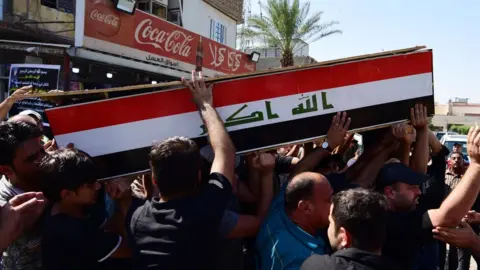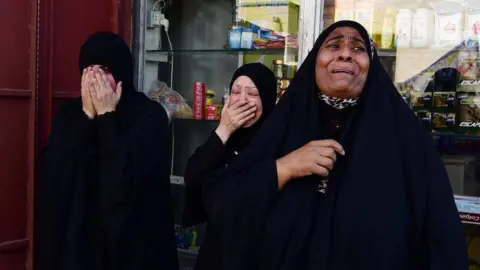Iraq troops used excessive force against protesters, official inquiry finds
 EPA
EPAAlmost 150 civilians were killed during protests in Iraq earlier this month as a result of security personnel using excessive force and live gunfire, a government committee has found.
About 70% of the deaths were caused by bullet wounds to the head or chest, according to the committee's report.
Chaos followed commanders losing control of their forces and many senior officers should be sacked, it adds.
The protesters demanded jobs, an end to corruption, and better public services.
Fresh demonstrations are planned for Friday, the first anniversary of Prime Minister Adel Abdul Mahdi taking office.
Mr Abdul Mahdi has promised a cabinet reshuffle and a package of reforms to address the protesters' demands.
The protests, which lacked any organised leadership, started in the capital Baghdad on 1 October. Most of those taking part were young and unemployed.
After security forces used live ammunition in an attempt to disperse the demonstrators, the unrest escalated and began to spread to other cities and towns.
On Tuesday, a committee tasked by Mr Abdul Mahdi with investigating the bloodshed released its report.
It says 149 civilians and eight security personnel were killed at protests between 1 and 6 October. Three-quarters of the deaths were in Baghdad province.
The committee concluded that "officers and commanders lost control over their forces during the protests" and that this "caused chaos", Reuters news agency cited the report as saying.
It also found evidence that a sniper operated out of an abandoned building in central Baghdad.
 EPA
EPAAmnesty International said two weeks ago that it had gathered audio-visual material depicting a pattern of shootings that were consistent with sniper fire in Baghdad.
The Iraqi authorities blamed "anonymous snipers" for the killing of protesters, but witnesses said the sniper fire was coming from behind the security force lines.
The committee recommended that dozens of senior security officials should be dismissed and referred to prosecutors for possible trial, including the Baghdad operations commander.
However, it stopped short of blaming the prime minister and other senior officials.
"There were no official orders from the supreme authorities to security forces to open fire towards protesters or use live ammunition at all," the report says.
